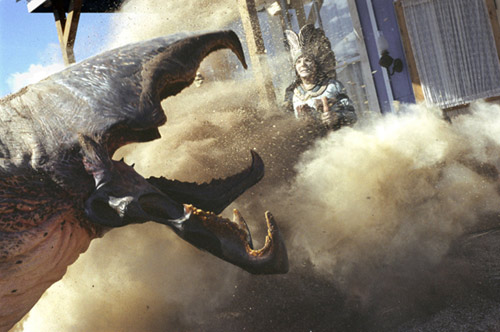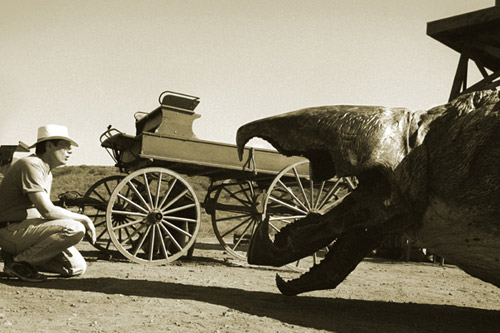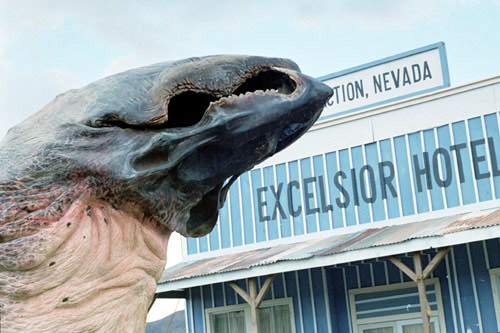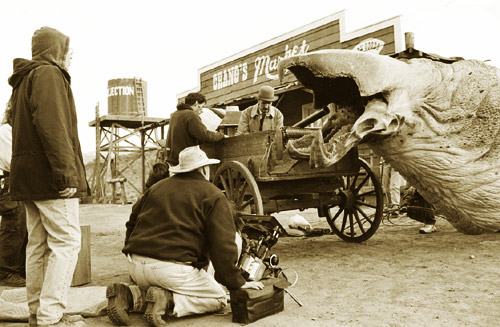The fourth chapter in the Tremors series depicts the Graboids first attacking the city of Perfection (then called Rejection) in 1889, 100 years before the first film. When discussions about the projects began writer Steven S. Wilson met with Universal executive Patti Jackson. “I told Patti that we were really in a corner,” Wilson told Cinefex online. “The fans were going to want a new creature, but we had no idea where to go. We couldn’t just keep doing the same movie over and over.” He then added: “we’d have to do something wacky this time, like set it in the Old West.” Jackson’s response was concise: “that’s fine.”
Whilst Amalgamated Dynamics did not return to provide the effects, Alec Gillis and Tom Woodruff, Jr. supervised the creation of the new Graboids. Several special effects crewmembers from the original film did collaborate on Tremors 4, including Robert Kurtzman and the miniature artists Dennis and Robert Skotak. The practical effects were provided by Greg Nicotero’s KNB Efx, who had already worked on Tremors: The Series. “We’re definitely going back to the old school,” Nicotero said.
An imperative for the film was not to use digital effects extensively. “The decision was primarily financial, but also partly aesthetic,” Wilson told The Official UK Tremors. “Tremors 3 was the first film in which we used CGI to create Graboids. While we had excellent people doing the work, we found we did not have the money to keep redoing the shots until we got them really looking perfect.” He also added that “Graboids are particularly difficult because they kick up so much dirt and dust, which are chaotic elements very difficult to create in CG. When we ran the budget for Tremors 4, our FX expert, Linda Drake, determined that we could do more shots with miniatures than we could with CG. That suited us fine, because the Skotaks — our Academy Award-winning miniature artists from Tremors 1 — were available and wanted to work with us again. That made it a no-brainer. Tremors 4 has the most active, aggressive Graboids yet, and they’re all done the old fashioned way — with full-scale puppets — from KNB — and tentacles and miniatures.”
Listening to the series’ enthusiasts in regards to this matter was a primary concern. “We really listened to the fans,” Wilson related. “The only negative comments we’d ever heard about our special effects — as low-budget as they’d been — concerned the CG Graboids we did for Tremors 3. They were faster and much livelier than the big, heavy puppets we’d used in the earlier versions; but, although the effects were first-rate, fans said that they didn’t ‘look right.’ And, of course, they were also more expensive.”

In Tremors 4: The Legend Begins, a silver mine owned by Hiram Gummer — an ancestor of Burt — is attacked by recently awakened Graboids. Following the concepts introduced in the previous film, the Graboids hatch from eggs, and as such would first appear as a larval stage — the so-called ‘Grabite’. “We took the original design,” Nicotero said, “and then we kind of said what would these thirty-foot creatures look like if they were four and a half feet long? They were kind of the cherubic infant version. Ultimately, what we ended up doing was a couple, like four or five different sketches. So we made them look like grubs, they had these infantile little mandibles and little tiny nubs of teeth growing in and little sort of feelers, so that that you get the impression that this was the precursor to the adult.”
KNB built the Grabites as full-sized remote-controlled animatronics and hand puppets used on set with artificial dirt for the scenes where they burst from the ground or drag their victims under it; puppets were additionally composited into shots for the scenes where the creatures are seen springing from the ground “like some demonic trout.”
KNB’s work on Tremors: The Series — for which a full-sized El Blanco puppet was built — proved useful: the new full-size Graboid animatronic head sections — 12 feet long and built based on the original moulds — featured the structural innovations of the El Blanco puppet, and had their foundation on the same moulds.
The new animatronics were cable-operated and were installed on four-wheeled dollies, which enabled greater maneuverability compared to previous versions; they could perform wide ranges of movements based on a single pivot point. Mechanically, the Graboids featured an additional articulation point in the neck, as well as a different structural design for the mouth interior that enabled actors to actually slide down the creature — for scenes such as Kelly’s death — through the use of collapsible panels. Four puppeteers were needed to maneuver the creatures. Full-size tentacle animatronics and hand puppets were also built.

Budget restraints did not allow Tremors 4 to be shot in the original locations chosen for Perfection — Lone Pine — and had to resort to a more affordable place: Acton, California. For most of the bursting scenes, previous films had employed the full-size animatronic heads, installed on elevating rigs and buried in the ground, with a destructible covering. Such a stunt could not be performed on the location of Tremors 4, due to ground composition. Wilson recalled: “the town was half-built, and I went out and selected where I was going to plant our eight-foot puppet. But then, production designer Simon Dobbin came to us and said: ‘Guess what? To dig holes out here we’re going to have to blast.’ The area was solid rock underneath. It caused our visual effects producer, Linda Drake, to go back to the drawing board very quickly and come up with an entirely different approach.”
The full-size puppets were filmed only above ground, and were never seen bursting from it — with the exception of the Graboid trying to devour Juan in the muling station, which was filmed in an elevated set. “That was a very complicated shot, and we only had one chance to get it right,” Wilson said in the Ultimate Tremors FAQ. “We duplicated the entire telegraph room on top of two steel shipping containers (the big ones they put on ships) so we’d have space to work underneath. The entire floor was made of super delicate balsa wood. You couldn’t stand on it. You could barely touch it and it would break. So we had to ‘fly’ Brent Roam’s stunt double on cables above the floor. When the puppeteers smashed the Graboid through from below, the stunt crew tried to yank the double up at the same speed so it would look like he was carried up by the Graboid. Unfortunately, the Graboid got a little hung up and our Juan double flew up faster. Linda Drake’s visual effects people worked really hard to try to blend the action together — by adding dust and boards and trying to digitally move Juan and the Graboid closer together.”
He also added that “in all the closer shots that’s really Brent Roam doing his own stunts. He loved riding the Graboid.”

The same sequence employed miniature tentacles filmed separately against greenscreen and composited with the full-size Graboid by Kevin Kutchaver’s HimAnI Productions. “It worked marvelously well,” said Wilson. “We had these tentacles coming in and out of the Graboid’s mouth – yet we never shot the full-size tentacles on the set.”
Other shots of the tentacles employed insert hand puppets and animatronics. A tentacle dummy, filled with orange-tinted methocel and KY jelly, was used for when the Graboid’s tongue is torn off by the locomotive dragging the creature towards it.
Like the first two films, quarter-scale Graboid miniature puppets were built. KNB Efx provided the scaled puppets, which interestingly had two separate head sculptures to distinguish them. When the 4ward crew received the puppets, some modifications had to take place. “There were two graboid puppets we used,” said Jim Davidson, part of the 4ward crew. “Both were made by KNB, however, they were not made very puppeteer friendly — so Jim Towler had to completely re-make one of the heads from scratch to get improved movement and better performance.”
With the tweaks done, the puppets were shot in elevated miniature sets, such as the storage shed. “I was on the cable controls next to the set working the mouths and Pat Denver and Jim Towler were under the set puppeteering the bodies,” recalled Davidson.

Many other sequences were greenscreen elements of the Graboids bursting from the ground, which would later be composited with live-action footage. They were filmed at varying increased frames per second to enhance their sense of mass. “Compositing in the computer allowed us to do very complex composites,” Wilson said. “We could take advantage of image steadying and tracking, and we could do camera moves. It really gave us the best of both worlds to shoot miniatures and then composite them digitally.” Compositing was handled by HimAni Productions.
One particularly ambitious composite shot involved a Graboid bursting through the wall of a river bed under a bridge and then barreling through the other side. A miniature version of the bridge and surrounding landscape was built by the 4ward crew, with collapsible elements. A full miniature dummy of the Graboid (about six feet in length) was suspended under the bridge through a cable, which connected it with a moving cart on tracks above the bridge. Jim Davidson explained: “the puppet was suspended on a slot track above the set, and pushed or pulled through a breakaway opening with manually-timed compressed air and debris blasts through the rocky, gully hills under the bridge.”
The cart drove the Graboid across the bridge set, and additional head motion during the gross movement was also implemented. Davidson related: “to move the head during the shot there was a cable attached to the head of the puppet that led to the top of the track, and was rigged to ride along the edge of a curved piece of plywood. As the puppet rolled along the cable, the cable would be pulled up as it traveled over that plywood curve shape.”

In the final shot, the dolly was erased and the carriage (previously filmed against greenscreen during live-action photography) was composited in. The last touches included digital debris at the monster’s passage, simulating its breaking through dirt and rock.
The last Graboid’s death scene was another complex miniature sequence. The monster first rises from the ground, with the tip of its tail peeking through the dirt. This scene employed the miniature Graboid, intercut with the full-size puppet for close-ups and interactions.

When Hiram hooks the locomotive’s belt, it is a full-size tail; everything after that was filmed with a miniature Graboid. illed with foam latex guts and coloured KY Jelly blood — was hooked with a miniature cable and pulled towards a miniature locomotive, with the resulting explosion being a completely in-camera effect. “For me my goal always is to challenge the audience,” Nicotero ultimately commented. “I want to be able to do gags or shots where people will walk out and go ‘okay, how did they do that? Wow, that was cool. I never expected that.’ That’s the fun, that‘s the fun part.”
Special Thanks to Jim Davidson for the pictures and information uploaded to his Facebook page!
For more pictures of the Graboids, visit the Monster Gallery.
Previous: Tremors: The Series
Next: Tremors 5: Bloodlines
















[…] in the franchise except for that it takes place in the Old West, because producers wanted a hook to make the film feel “wacky.” The movie tells the story of the founders of Perfection and how they were too stupid to leave their […]
[…] Previous: Tremors 4: The Legend Begins […]
[…] Recommended Links:https://monsterlegacy.net/2014/09/20/subterranean-terror-tremors/https://monsterlegacy.net/2014/09/24/subterranean-terror-tremors-2-aftershocks/https://monsterlegacy.net/2014/09/25/subterranean-terror-tremors-3-back-to-perfection/https://monsterlegacy.net/2014/09/26/subterranean-terror-tremors-4-the-legend-begin/Notes from the book Seeking Perfection: The Unofficial Guide to Tremors […]
[…] Recommended Links:https://monsterlegacy.net/2014/09/20/subterranean-terror-tremors/https://monsterlegacy.net/2014/09/24/subterranean-terror-tremors-2-aftershocks/https://monsterlegacy.net/2014/09/25/subterranean-terror-tremors-3-back-to-perfection/https://monsterlegacy.net/2014/09/26/subterranean-terror-tremors-4-the-legend-begin/Notes from the book Seeking Perfection: The Unofficial Guide to Tremors […]